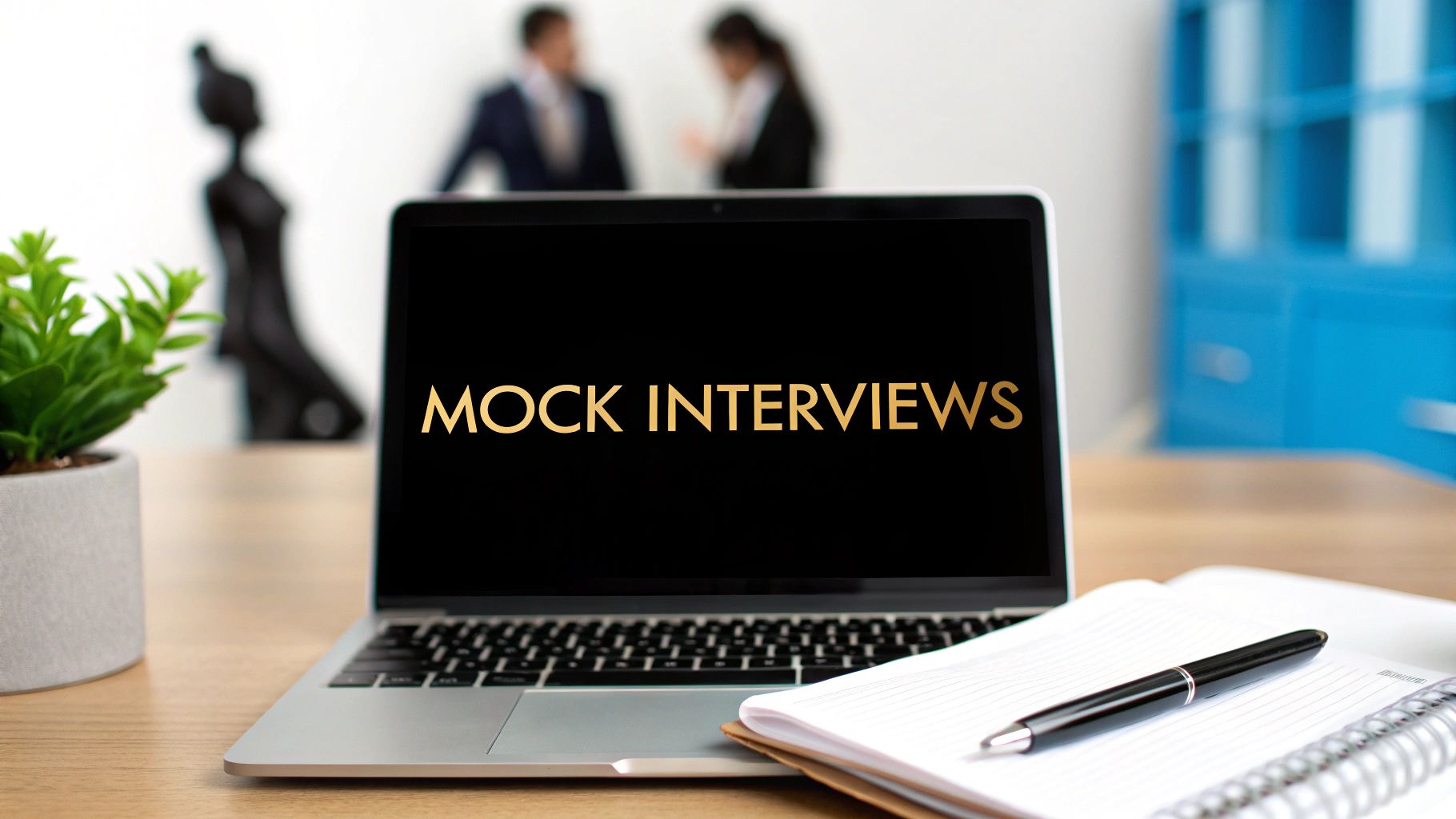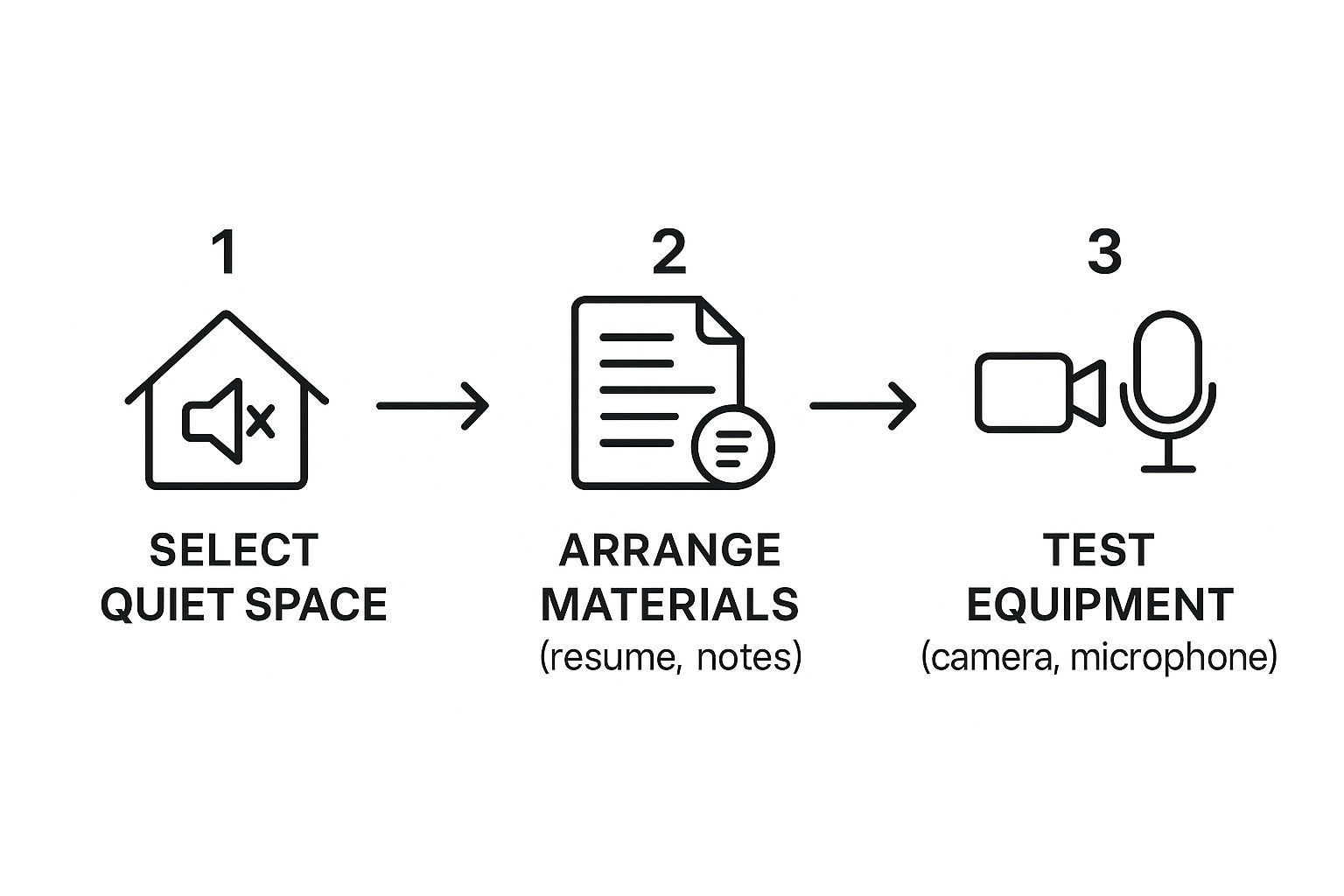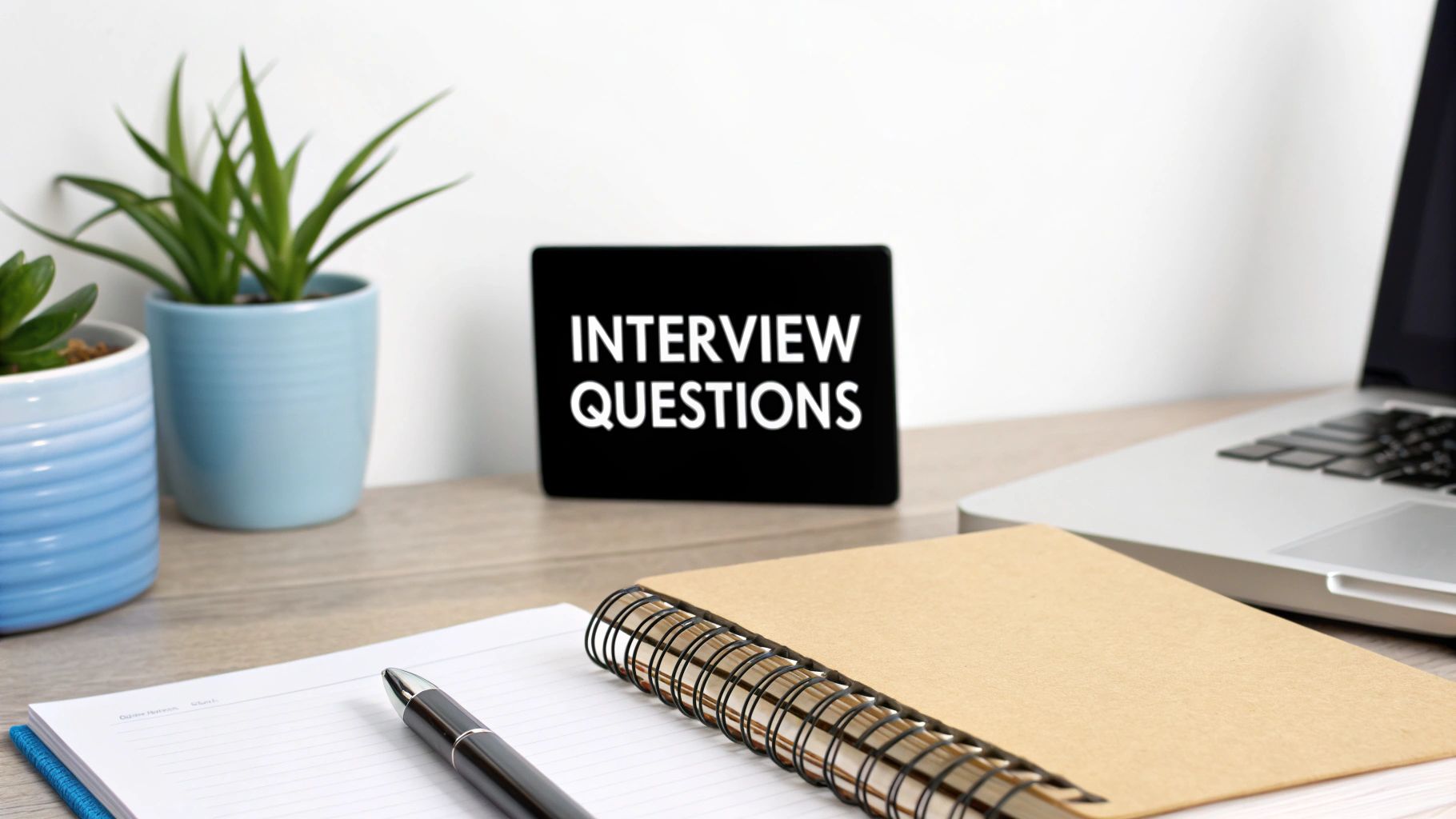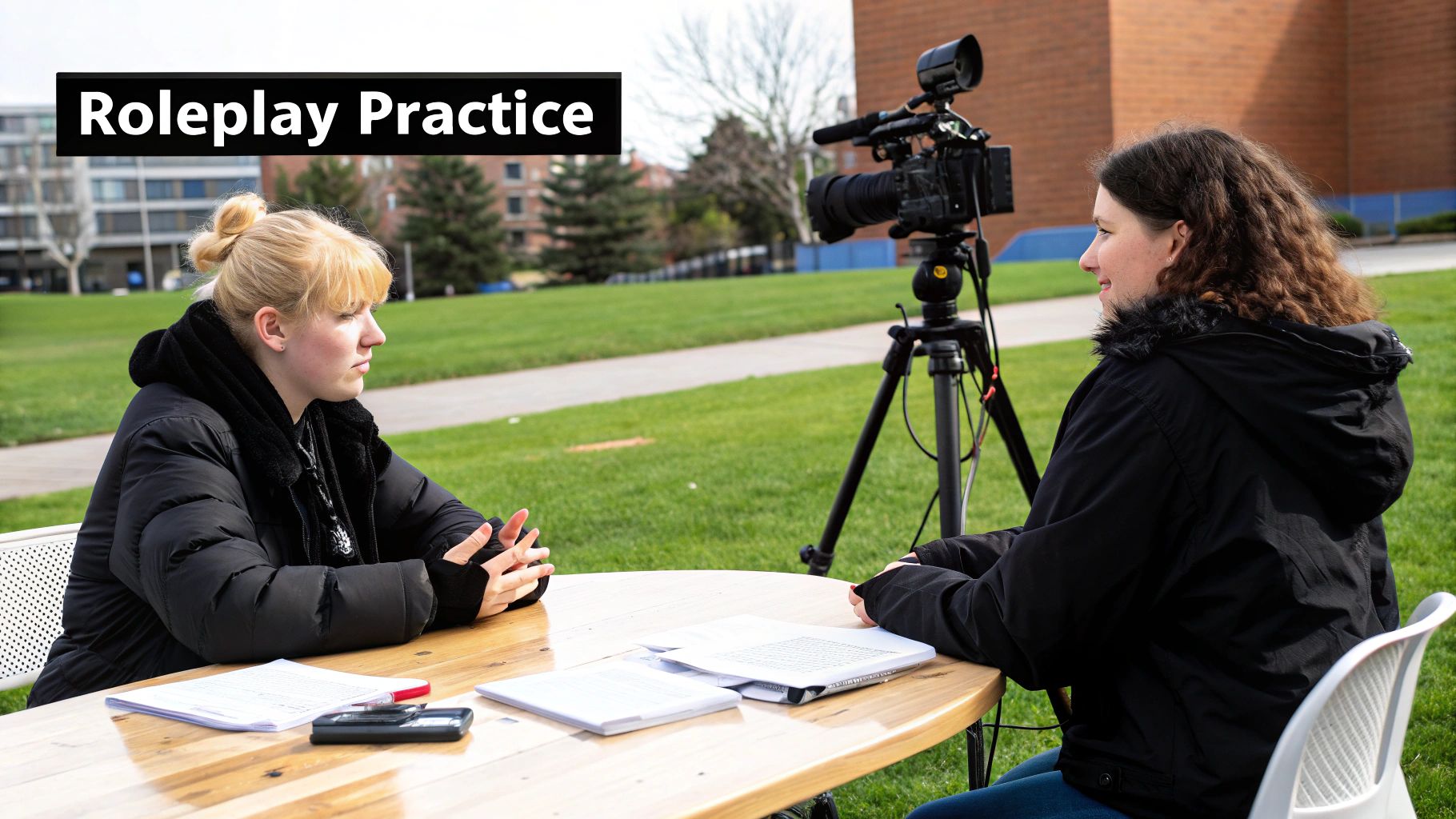How to Conduct Mock Interviews That Secure Job Offers

A good mock interview really comes down to three things: designing a realistic simulation, running the session like a pro, and giving feedback that actually helps. This isn't just about rehearsing answers. It's about creating a safe space to build confidence, sharpen your story, and master the art of thinking on your feet.
Why Mock Interviews Are Your Secret Weapon

In today's job market, a killer resume might get you in the door, but the interview is where the real magic happens. Just winging it is a surefire way to miss out on a great opportunity. This is exactly why learning how to conduct a proper mock interview is such a game-changer—it turns hopeful guessing into a real strategy.
Structured practice goes way beyond memorizing answers. It's about stress-testing your entire performance. Think of it as a dress rehearsal where it's totally fine to stumble, feel the nerves, or completely blank on a question without any real-world fallout. This is how you build resilience and tackle that all-too-common interview anxiety.
A great mock interview is built on a few core principles. I like to think of them as the four pillars that hold up the entire structure, turning a simple practice run into a powerful preparation tool.
The Four Pillars of an Effective Mock Interview
| Pillar | Objective | Key Action |
|---|---|---|
| Realism | Simulate the actual interview environment as closely as possible. | Use real job descriptions, time limits, and question types (behavioral, technical). |
| Performance | Focus on the candidate's delivery, not just their answers. | Observe body language, tone, pacing, and how they handle pressure. |
| Feedback | Provide specific, constructive, and actionable advice for improvement. | Go beyond "good job" with concrete examples of what worked and what didn't. |
| Repetition | Build muscle memory and confidence through repeated practice. | Conduct multiple sessions, focusing on different skills or question types each time. |
By keeping these four pillars in mind, you ensure the practice session delivers maximum value and truly prepares the candidate for what's to come.
The Confidence Factor
Let's be clear: confidence isn't just about feeling good—it's about projecting competence. When you've already grappled with tough behavioral questions or navigated tricky technical problems in a practice setting, you walk into the real interview with a sense of calm and control.
This kind of practice helps you:
- Nail your personal narrative: You can test-drive your accomplishment stories until they’re sharp, concise, and genuinely impactful.
- Improve non-verbal cues: Get direct feedback on your body language, eye contact, and vocal tone, which often say more than your words.
- Get comfortable with the pause: It's a sign of a thoughtful candidate, and practice helps you learn to take a moment to structure your thoughts before diving in.
A well-run mock interview does more than prepare you for questions; it prepares you for pressure. It transforms your approach from reactive to proactive, giving you control over the interview dynamic.
A Growing Market for Preparedness
The value of this kind of preparation is no secret. The global mock interview service market was valued at around $1,042.9 million—a number that speaks volumes about how seriously candidates are taking this step. And it's not slowing down. That market is projected to hit $2,500 million by 2035, which is a clear sign that effective interview practice is becoming a necessity, not a luxury.
One of the biggest payoffs from mock interviews is the chance to sharpen critical communication and interpersonal skills. To see how these abilities fit into the bigger picture, it's worth exploring the essential soft skills leaders need in today's workplace.
Ultimately, this preparation ensures you walk into that room ready not just to answer questions, but to lead a compelling conversation about the value you bring.
Designing a Realistic Interview Simulation
A great mock interview isn't about winging it; it’s about deliberate, intentional design. If you want the practice to actually work, you need to build a simulation that feels just like the real thing—pressure, structure, and all. That process starts with having a single, clear objective for the session.
What’s the main goal here? You can't fix everything in one go. Pinpoint your focus. Are you trying to improve:
- Behavioral Questions? This is where you'd practice telling your career stories using frameworks like STAR (Situation, Task, Action, Result).
- Technical Challenges? Maybe you need to work through a coding problem or a case study against the clock.
- Overall Delivery? Sometimes the goal is simply to work on body language, slow down your speaking pace, or just project more confidence.
Once you know your goal, you can pick the right questions. Ditch the generic lists you find online. Instead, pull keywords and requirements straight from the job description. Hunt through forums like Reddit or Glassdoor to find questions people say they were asked for that exact role at that specific company. This makes the practice run feel incredibly relevant.
Creating the Right Environment
The space you choose—whether it's physical or virtual—is what sets the tone. Your mission is to kill all distractions and mimic a formal setting as closely as you can. A casual chat on the couch simply won't trigger the same nerves as a high-stakes conversation, and that's what we're trying to replicate.
This simple flow chart breaks down the essentials for getting your space ready, whether you're meeting in person or over a video call.

As you can see, a successful setup isn’t complicated. It’s just about being intentional with your space, having your materials ready, and double-checking your tech to make sure a glitch doesn't derail the entire session.
To make it feel even more real, the simulation should also include what you're going to wear. This is a perfect opportunity for candidates to master the business casual dress code and make sure their first impression is as strong as their answers. It’s a detail that’s easy to overlook but adds a powerful layer of realism to the practice.
Choosing the Right Interviewer
The person on the other side of the table is just as important as the questions they ask. Who you choose directly shapes the quality of the feedback you get. A close friend might be too nice to tell you the hard truth, while a complete stranger might not have the industry context to give you relevant advice.
Here are a few solid options for a practice partner:
- A Mentor or Manager: Find someone with real industry experience. They can give you expert, objective feedback on your answers because they know what a great candidate actually looks and sounds like.
- A Peer: A colleague who's also job hunting can be a fantastic choice. They're in the trenches with you, so they can offer a relatable perspective and often spot weaknesses that a manager might miss.
- An AI Tool: Don't discount technology. Platforms built for interview practice can give you instant, data-driven feedback on your filler words, speaking pace, and keyword usage, all without any human bias.
The best interviewer is someone who is willing to provide honest, sometimes uncomfortable, feedback. Their job isn't to be your cheerleader; it's to be a coach who pushes you to get better before the real game.
Running the Session Like a Professional

Alright, you’ve done the prep work. Now it's time to run the mock interview itself. This is where all that planning pays off, but it requires both the interviewer and the candidate to play their parts convincingly to get the most out of the experience. The aim is to create an atmosphere that feels just like the real thing.
If you’re the one playing the interviewer, your job is to set a professional tone right from the start. Introduce yourself, give a quick rundown of how the session will go, and then get straight to the questions. You're also the timekeeper, so you need to steer the conversation to cover the important ground without making the candidate feel rushed.
As you go, your note-taking needs to be sharp. Don't just transcribe their answers. Pay attention to the details—their confidence, how they structure their thoughts, and their overall delivery. These observations are gold when it comes to giving feedback later.
For the Person in the Hot Seat
If you're the candidate, your one and only job is to stay in character. Fully commit. Treat every question like it's coming from a hiring manager at your dream company. That means no winking at the camera, no self-deprecating jokes if you mess up, and no breaking character to ask about the process.
To keep your answers sharp and on point, lean on the STAR method. It's a classic for a reason—it works. This simple storytelling framework ensures your answers are compelling, not rambling.
- Situation: Set the scene. What was the context or challenge?
- Task: What was your specific goal or responsibility?
- Action: Walk them through the specific steps you took to handle it.
- Result: What was the outcome? Share the positive impact or what you learned.
Using this framework is a fantastic way to give concrete, evidence-based examples of your skills, especially for those tricky behavioral questions. It’s a total game-changer.
What separates a good candidate from a great one is often their ability to handle the unexpected. A mock interview is the perfect arena to practice turning a moment of panic into a display of poise and thoughtful problem-solving.
Managing Curveballs and Pressure
Inevitably, a question will catch you off guard. It happens to everyone. What matters most isn't having a perfect answer immediately, but how you handle that moment of pressure.
It is perfectly fine to say, "That's a great question. Let me take a moment to think about that."
This simple phrase is incredibly effective. It buys you a few crucial seconds to gather your thoughts, and it signals to the interviewer that you're thoughtful and deliberate, not just blurting out the first thing that comes to mind.
If you deliver an answer that you feel was weak, don't let it shake you. Just make a mental note to work on that area later. The whole point of this exercise is to find those weak spots now, in a safe environment, not in a high-stakes interview.
Remember, the job market is no joke. On average, a single corporate job opening attracts 118 applicants, but only about 20% of them even get an interview. With roughly 31% of those interviewed candidates getting an offer, this kind of focused practice can absolutely be the thing that puts you over the top. It's worth diving into more data on modern hiring challenges to see what you're up against.
A well-run mock interview should feel dynamic. It pushes the candidate, gives the interviewer valuable insights for feedback, and transforms a simple practice session into a powerful learning experience. You're building the muscle memory you'll need to perform under pressure when it really counts.
Giving Feedback That Actually Helps Someone Improve

The real magic of a mock interview doesn't happen during the Q&A. It happens afterward. The feedback session is where you turn a simple practice run into real, tangible improvement. Without a thoughtful, constructive critique, the whole thing is just a chat. Good feedback is what connects a decent attempt to a truly great performance.
The point isn't just to list off everything someone did wrong. It’s about handing them a clear roadmap for what to do next. Vague comments like "be more confident" are completely useless—they don't tell the person how. You have to zero in on specific behaviors and small, concrete adjustments they can actually practice.
A big part of this is separating the content of an answer from its delivery. A candidate could have an amazing story about tackling a tough problem, but if they tell it in a rambling, monotone voice, all that impact is lost. You've got to assess both pieces of the puzzle to give them the full picture.
A Simple Structure for Clear Feedback
Winging it doesn't work. To keep the feedback session from turning into a disorganized list of complaints, you need a framework. One of the best I've ever used is the Start, Stop, Continue model. It's straightforward, balanced, and gives people crystal-clear next steps.
Here’s a breakdown of how it plays out in a real session:
- Start: "You should start adding specific numbers to back up your project results. For example, instead of just saying you 'improved efficiency,' say you 'cut processing time by 15%.' It makes the accomplishment so much more powerful."
- Stop: "Try to stop using filler words like 'um' and 'like' when you're thinking. It's totally fine to take a quiet pause for a second—it actually makes you sound more thoughtful."
- Continue: "Definitely continue using the STAR method for those behavioral questions. The way you walked me through that product launch story was perfectly structured and super easy to follow."
This approach naturally balances praise with constructive pointers, which helps people hear and absorb the advice without getting defensive. It goes way beyond generic compliments and reinforces the specific things they're already doing well.
The best feedback feels less like a judgment and more like a strategy session. Your goal is to arm the candidate with the exact tools they need to nail it next time, turning weak spots into areas for focused practice.
Turning Vague Advice into Actionable Steps
The gap between helpful and unhelpful feedback almost always comes down to one thing: specificity. If you really want to get good at conducting mock interviews that create real change, you have to master this. Let's look at how to reframe some common but ineffective feedback.
From "Meh" to Meaningful Feedback
| Instead of This (Vague) | Try This (Actionable) | Why It's Better |
|---|---|---|
| "Your answers are too long." | "Aim to keep your answers under two minutes. Let's try condensing your project example again, but this time, focus on just three key outcomes." | It gives them a concrete time limit and a specific exercise to practice. |
| "You need to sound more confident." | "When you introduced yourself, your voice was really strong, but it tended to trail off at the end of your sentences. Focus on keeping that same volume all the way through." | It pinpoints a specific vocal habit they can actually hear and fix. |
| "Your body language was a bit off." | "I noticed you were looking down at your desk a lot. A good goal is to maintain eye contact with the camera for at least 70% of the time. Let's work on that." | It provides a measurable target related to a clear non-verbal cue. |
When you get this specific, you're moving from opinion to observation. You're not just telling them what’s wrong; you're showing them exactly how to make it right. This is the kind of detailed coaching that builds real skills and confidence that sticks. Every piece of feedback should be a stepping stone, not a stumbling block.
Using Technology to Sharpen Interview Skills
Modern tools have completely upended how we prepare for interviews. Gone are the days of relying solely on a willing friend or mentor. Now, technology offers instant, data-driven feedback on nuances a human observer might easily miss, turning interview prep into a much more precise science.
There's a reason the market for this technology is blowing up. The mock interview software space, valued at around $0.7 billion in 2023, is projected to grow by roughly 13.5% each year through 2030. This boom shows just how many job seekers are looking for a tech-driven edge. You can dig into the numbers yourself in this report on the mock interview system market.
These tools are a game-changer, especially when you need to run mock interviews on your own. For a closer look, our blog has more on how to use AI for better job interview prep.
AI-Powered Feedback Platforms
AI platforms are built to dissect your performance at a micro-level. They track metrics that are practically impossible for a person to measure accurately in the middle of a conversation.
Here’s a taste of what these tools typically give you feedback on:
- Speaking Pace: Are you rushing through your answers because you're nervous? Or speaking too slowly? The AI will give you a concrete words-per-minute score to work with.
- Filler Words: You’ll get an exact count of how many times you leaned on crutch words like "um," "uh," and "like," helping you sound more confident and articulate.
- Eye Contact: When you're practicing on video, some platforms can even analyze how consistently you maintain eye contact with the camera, which is key for virtual interviews.
The real magic of AI feedback is its brutal honesty. It's completely objective. It doesn't worry about your feelings; it just delivers the raw data you need to pinpoint and fix specific habits that might be undermining your performance.
Peer-to-Peer Practice Platforms
Another fantastic option is peer-to-peer platforms. These services connect you with other job seekers for back-and-forth mock interviews. It’s a great way to practice with someone who is in the exact same boat and truly understands the pressure you're facing.
This screenshot from Pramp, a well-known platform for tech interviews, gives you an idea of how it works.
You can see how users get matched based on their target roles and experience, which ensures the practice session is actually relevant. These platforms usually come with a set of questions and a structured format, so you can dive right into a realistic simulation with a peer without any awkward setup.
Answering Your Top Mock Interview Questions
Even with the best-laid plans, a few nagging questions always seem to surface when you start doing mock interviews. Getting these sorted out is often what separates a genuinely helpful practice run from a frustrating one. Let’s clear up some of the most common sticking points I see.
How Many Mock Interviews Is Enough?
This is probably the most frequent question I get. While there's no single magic number, my experience shows that 2-3 focused sessions is the sweet spot for most people before the real thing.
Think of it like this:
- The Diagnostic Run: Your first session is all about discovery. Where are the big, obvious gaps? Are you rambling? Do your STAR method examples fall flat? This is your baseline.
- The Refinement Round: In this session, you’re putting the feedback from round one into action. You're consciously working on tightening up your stories, being more concise, and fixing those specific issues you uncovered.
- The Dress Rehearsal: The final practice is for building confidence. The goal here is to polish your delivery, smooth out any remaining awkward spots, and get into the right headspace.
Of course, if you're switching careers or it's been a while since your last interview, adding another session or two can help shake off the rust.
Who Should I Practice With?
Choosing your practice partner is critical. It's so tempting to just grab a friend or your spouse, but they often struggle to give you the brutally honest feedback you actually need. They care about your feelings, which is great in life but not so helpful here.
Your best bet is to find someone who gets your industry and can be objective. A trusted mentor, a former manager you had a good relationship with, or a professional career coach are all fantastic options. They have the right context to tell you what a hiring manager in your field is really listening for, and their feedback will be sharp, relevant, and actionable.
What If I Get Conflicting Advice?
It’s bound to happen. You do one mock interview and get told your answer to "Tell me about yourself" was brilliant. You do another with someone else, and they tell you it was a complete mess. So, who do you listen to?
Don't treat every piece of advice as a command. Look for the patterns.
Conflicting feedback isn't a problem—it's data. If one person doesn't like an answer but two others think it’s great, the majority probably has it right. Your real job is to filter all this advice through what feels authentic to you and what you know about the company's culture.
When you hear the same thing from multiple sources—like you’re speaking too fast or a specific project example isn't landing—that's a strong signal you need to make a change. In the end, you're the one in the driver's seat. Take in the feedback, find the common threads, and adjust in a way that lets you show up as your best self.
Ready to take your interview preparation to the next level? ParakeetAI provides real-time, AI-powered assistance to help you answer any question with confidence. Stop guessing and start acing your interviews. Get your lifetime access today at https://www.parakeet-ai.com.




